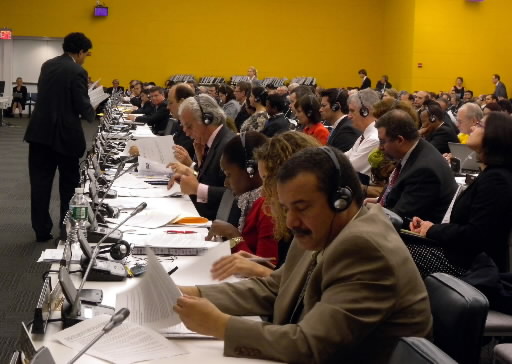Nuclear Weapons Can Be Eliminated: Chapter 11, Part 1
Jun. 7, 2010
Chapter 11: 2010 NPT Review Conference
Part 1: Background of the final agreement
by Yumi Kanazaki, Staff Writer
Coordination concerning the Middle East yields results
The Nuclear Non-proliferation Treaty (NPT) Review Conference, which is held every five years, has adopted a final document with an action plan of 64 items in pursuit of nuclear disarmament, non-proliferation, and the peaceful use of nuclear energy. However, there were concerns that the discussions, which took place over a period of four weeks, from May 3-28, at United Nations Headquarters in New York, might break down, as they did at the review conference five years ago, if a wrong move was made. The Chugoku Shimbun reflects on the developments, including actions taken behind the scenes, of this year's NPT Review Conference, which has managed to sustain the international momentum for nuclear disarmament.
On the early afternoon of May 27, with one and a half days left until the closing of the conference, Yasuyoshi Komizo, ambassador of the Permanent Mission of Japan to the International Organizations in Vienna, still wore a tense expression: "If only the issue of the Middle East resolution can be settled, we'll be there." Libran Cabactulan of the Philippines, the president of the conference, had promised to present a draft of the final document at 5 p.m., which was only a few hours away.
The 1995 NPT Review Conference, which decided the indefinite extension of the NPT, adopted the "Resolution on the Middle East." The contents declaring the denuclearization of the Middle East imply that Israel, which is presumed to possess nuclear arms, will be forced to give up its nuclear weapons. However, no progress was made on this matter for the past 15 years. How to deal with the Middle East resolution and whether Arab nations would accept it became the biggest pending issue at the conference this time.
In the late afternoon of that day, copies of the president's draft of the final document were distributed, which included a proposal to hold an international conference in 2012 to discuss the denuclearization of the Middle East and a call for Israel to join the NPT by mentioning the nation by name. The draft signified that Arab nations and the United States found compromise in line with an earlier draft presented on May 21.
This outcome was also the result of continuous efforts by Alison Kelly of Ireland, the chair of Subsidiary Body 2, which focused on regional issues, including the Middle East. She served as a facilitator between Egypt, the leader of the League of Arab States and the host nation of the conference of the Non-Aligned Movement (NAM), and the United States, which defended Israel.
Proposal turns the tide
Arab diplomatic sources pointed out that the balanced proposal put forth by Ms. Kelly on May 21 had helped turned the tide. The heated negotiations between the United States, which had sought to remove all language identifying Israel by name, and the Arab side, who had wanted a more stern reference to Israel, continued behind the scenes. In the end, the two sides made mutual concessions in the final stage of the negotiations.
Still, there remained a concern: The attitude of Iran, which has persisted in uranium enrichment at home and has been harshly criticized by the United States and other nations. Iran continued to maintain, not only with regard to Middle East issues but on other subjects on various occasions, that the discussions had not been sufficiently thorough. Other nations became uneasy, thinking that Iran was aiming to let the time run out and the conference to break down.
In such conditions, it was Egypt that made an all-out effort to persuade Iran to compromise. Those close to President Cabactulan explained that Egypt had, on its honor as a leader of Arab nations, sought to achieve results with regard to the Middle East resolution. Japan's diplomatic sources also analyzed that "Iran eventually became isolated from the other NAM nations."
Disadvantageous to nuclear disarmament
The fact that the United States, which had pushed for the success of the conference, agreed not to include criticism of Iran by name in the final document, despite verbal attacks against the nation, also contributed to the final agreement.
On the other hand, due to the "grand bargain" method, in which all subjects of discussions are put on the table and negotiated en masse, a number of items were removed or diluted after the wheeling and dealing. A typical example that "received the short end of the stick" was the area of nuclear disarmament.
(Originally published on June 3, 2010)
To comment on this article, please click the link below. Comments will be moderated and posted in a timely fashion. Comments may also appear in the Chugoku Shimbun newspaper.








